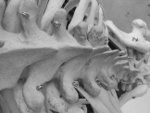 In a recent article published in Spine, 20 ankylosing spondylitis patients were the subjects of prospective study to determine a new technique for finding the required angle for spinal osteotomy. The authors of the study gathered pre- and postoperative spinal and pelvic radiographs from the patients, who underwent spinal osteotomy for kyphotic deformity correction. The ideal postoperative pelvic tilt and necessary angular correction was determined using the plumbline of the hilus pulmonis as the gravity axis of the trunk, rather than C7.
In a recent article published in Spine, 20 ankylosing spondylitis patients were the subjects of prospective study to determine a new technique for finding the required angle for spinal osteotomy. The authors of the study gathered pre- and postoperative spinal and pelvic radiographs from the patients, who underwent spinal osteotomy for kyphotic deformity correction. The ideal postoperative pelvic tilt and necessary angular correction was determined using the plumbline of the hilus pulmonis as the gravity axis of the trunk, rather than C7. The study found the pre- and postoperative Cobb T1 to be 52 degrees and Cobb S1 to be 3 degrees. The 20 subjects of the study showed increased sacral slope and decreased sagittal vertical axis and pelvic tilt. A 6-month follow-up showed patient quality of life to be significantly improved.
The study concluded that this new method of calculating the angle of AS correction was efficacious and reproducible.
More Articles on Spine:
12 Investments to Strengthen Physician Portfolios: Report
9 Recent Spine Surgeon Honors
Developing a Multidisciplinary Spine Center of Excellence: Q&A With DR. Jason Brodkey of Ann Arbor Spine Center


